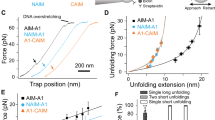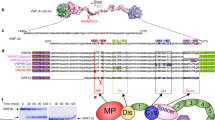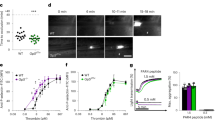Abstract
Platelet participation in hemostasis and arterial thrombosis requires the binding of glycoprotein (GP) Ibα to von Willebrand factor (vWF). Hemodynamic forces enhance this interaction, an effect mimicked by the substitution I546V in the vWF A1 domain. A water molecule becomes internalized near the deleted Ile methyl group. The change in hydrophobicity of the local environment causes positional changes propagated over a distance of 27 Å. As a consequence, a major reorientation of a peptide plane occurs in a surface loop involved in GP Ibα binding. This distinct vWF conformation shows increased platelet adhesion and provides a structural model for the initial regulation of thrombus formation.
This is a preview of subscription content, access via your institution
Access options
Subscribe to this journal
Receive 12 print issues and online access
$189.00 per year
only $15.75 per issue
Buy this article
- Purchase on Springer Link
- Instant access to full article PDF
Prices may be subject to local taxes which are calculated during checkout




Similar content being viewed by others
References
Ruggeri, Z.M. In von Willebrand factor and the mechanisms of platelet function. (ed., Ruggeri, Z.M.), 33–77 (Springer, Berlin; 1998).
Savage, B., Saldivar, E. & Ruggeri, Z.M. Cell 84, 289– 297 (1996).
Savage, B., Almus-Jacobs, F. & Ruggeri, Z.M. Cell 94, 657– 666 (1998).
Ruggeri, Z.M., Dent, J.A. & Saldivar, E. Blood 94, 172– 178 (1999).
Tschopp, T.B., Weiss, H.J. & Baumgartner, H.R. J. Lab. Clin. Med. 83, 296– 300 (1974).
Fuster, V., Badimon, L., Badimon, J.J. & Chesebro, J.H. N. Engl. J. Med. 326, 242–250 (1992).
Fuster, V., Badimon, L., Badimon, J.J. & Chesebro, J.H. N. Engl. J. Med. 326, 310–318 (1992).
Miyata, S. & Ruggeri, Z.M. J. Biol. Chem. 274, 6586–6593 (1999).
Marchese, P., Saldivar, E., Ware, J. & Ruggeri, Z.M. Proc. Natl. Acad. Sci. USA 96, 7837–7842 (1999).
Ware, J. et al. Proc. Natl. Acad. Sci. USA 88, 2946– 2950 (1991).
Ruggeri, Z.M., Pareti, F.I., Mannucci, P.M., Ciavarella, N. & Zimmerman, T.S. N. Engl. J. Med. 302, 1047–1051 ( 1980).
Ruggeri, Z.M. & Zimmerman, T.S. J. Clin. Invest. 65, 1318–1325 ( 1980).
De Marco, L., Girolami, A., Zimmerman, T.S. & Ruggeri, Z.M. Proc. Natl. Acad. Sci. USA 82, 7424– 7428 (1985).
Celikel,R., et al. Nature Struct. Biol. 5, 189– 194 (1998).
Emsley, J., Cruz, M., Handin, R. & Liddington, R. J. Biol. Chem. 273, 10396–10401 ( 1998).
Cruz, M.A. et al. J. Biol. Chem. 275, 19098– 19105 (2000).
Rabinowitz, I., et al. Proc. Natl. Acad. Sci. USA 89, 9846 –9849 (1992).
Xu, J., Baase, W.A., Baldwin, E. & Matthews, B.W. Protein Sci. 7, 158–177 (1998).
Blaber, M. et al. Biochemistry 32, 11363– 11373 (1993).
Vetter, I.R., et al. Protein Sci. 5, 2399– 2415 (1996).
Komives, E.A., et al. Biochemistry 34, 13612– 13621 (1995).
Zhang, Z., et al. Biochemistry 38, 4389– 4397 (1999).
Miyata, S., Goto, S., Federici, A.B., Ware, J. & Ruggeri, Z.M. J. Biol. Chem. 271 , 9046–9053 (1996).
Federici, A.B., et al. Thromb. Haemost. 78, 1132– 1137 (1997).
Brünger, A.T. X-PLOR crystallographic program suite (Version 3.851). (Yale University Press, New Haven, Connecticut; 1996).
Brünger, A.T., et al. Acta Crystallogr. D 54, 905– 921 (1998).
Usami, S., Chen, H.H., Zhao, Y., Chien, S. & Skalak, R. Ann. Biomed. Eng. 21, 77–83 (1993).
Esnouf, R.M. J. Mol. Graph Model 15, 132–134 (1997).
Sanner, M.F., Olson,A.J. & Spehner, J.C. Biopolymers 38, 305– 320 (1996).
Acknowledgements
We thank J. Ware for his assistance in the preparation of recombinant proteins and valuable suggestions during this entire project. We are also indebted to J.R. Roberts and R.A. McClintock for the expression and purification of vWF fragments and NMC-4 Fab; to J.A. Dent for assistance with the flow studies; to R. Habermann for help with image analysis and video editing; to U. Sen for assistance in computation; to M. Pique for preparing Fig. 4; and to B. Mathews for discussing the lysozyme mutants. This work was supported by National Institutes of Health grants and by the Rose and Sam Stein fund. The X-ray diffraction facilities were provided by N.H. Xuong at University of California, San Diego and the Stanford Synchrotron Radiation Laboratory.
Author information
Authors and Affiliations
Corresponding authors
Rights and permissions
About this article
Cite this article
Celikel, R., Ruggeri, Z. & Varughese, K. von Willebrand factor conformation and adhesive function is modulated by an internalized water molecule. Nat Struct Mol Biol 7, 881–884 (2000). https://doi.org/10.1038/79639
Received:
Accepted:
Issue Date:
DOI: https://doi.org/10.1038/79639



